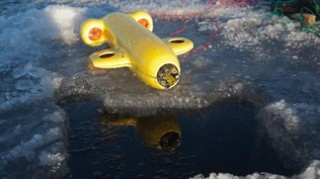May 4 2015
We’ve seen drones take to the sky, but what about underwater? EPFL startup Hydromea is developing a fleet of autonomous submersibles that can swarm out to study underwater environments.
 © 2015 Felix Schill – Hydromea
© 2015 Felix Schill – Hydromea
They look and move like something out of a science fiction film – sleek yellow submersibles powered by five bright orange rotors. They are agile, able to advance in all directions or hover in place. And soon, any number of these autonomous underwater vehicles (AUVs) will be able to interact with each other and fan out in swarms, taking the science fiction analogy to a whole new level. The inventors of the technology recently launched a startup, Hydromea, to develop and commercialize their underwater drones, which could open new doors for the exploration and the monitoring of underwater ecosystems.
With their submersibles, Hydromea is changing the paradigm in underwater environmental monitoring. “The way scientists sample lake water today is by sinking a sonde with multiple sensors vertically through the water column from a boat at various locations. This can take a long time. Instead, we can use multiple small AUVs [autonomous underwater vehicles] to collect more data faster. Our vehicle is much smaller, lighter, and more affordable than today’s AUVs, which are designed like torpedoes. And with our unique system of motors, it can patrol pre-programmed trajectories, even at low speeds,” says Alexander Bahr, a postdoc at the Distributed Intelligent Systems And Algorithms Laboratory (DISAL). Bahr co-invented the technology used by the submersible and is a co-founder of Hydromea.
Hydromea - AUV first dive
Hydromea - AUV first dive from Hydromea on Vimeo.
The submersible, which can be fitted with up to seven commercial sensors to measure a broad range of aquatic parameters, has a number of unique features. Its motors are not driven by a central shaft, but from the circumference. This makes them less prone to getting jammed by seaweed, fishing lines, or other floating obstacles. When a submersible surfaces, it can position itself using an integrated GPS and continue to track its location underwater using inertial sensors. And because all of the submersibles in the same swarm are synchronized with an extremely high precision clock and can communicate with each other and range off each other, all of the surrounding submersibles can determine their position based on one accurate reading.
According to Alexander Bahr, being able to collect data in swarms is central to collecting accurate snapshots of the underwater environment. “Of course you can float through a plume of polluted water with a submarine and collect data with environmental sondes, but if you return to the plume to collect a second profile, it will have been mixed and diluted by the first pass. The main advantage of using a swarm of vehicles is that we can take many samples, giving us enough data points to make out the shape of the plume,” he says.
The story behind Hydromea began in Australia in 2003, where Alexander Bahr, an electrical engineer, was doing an internship at the Australian National University in Canberra. His work was picked up by Felix Schill, trained as a computer scientist, who since then has become his sparring partner at Hydromea. Over the following years, they both came back to the project sporadically. And in 2011 their paths crossed again at EPFL, and they decided to join forces and put their energy behind the project. “We’ve basically had to develop and build everything from scratch, and getting funding is always a challenge,” says Bahr. But after all these years, the work is beginning to bear fruit. “We still have to some ways to go, but we hope to have a fleet of AUVs up and running in the coming months.